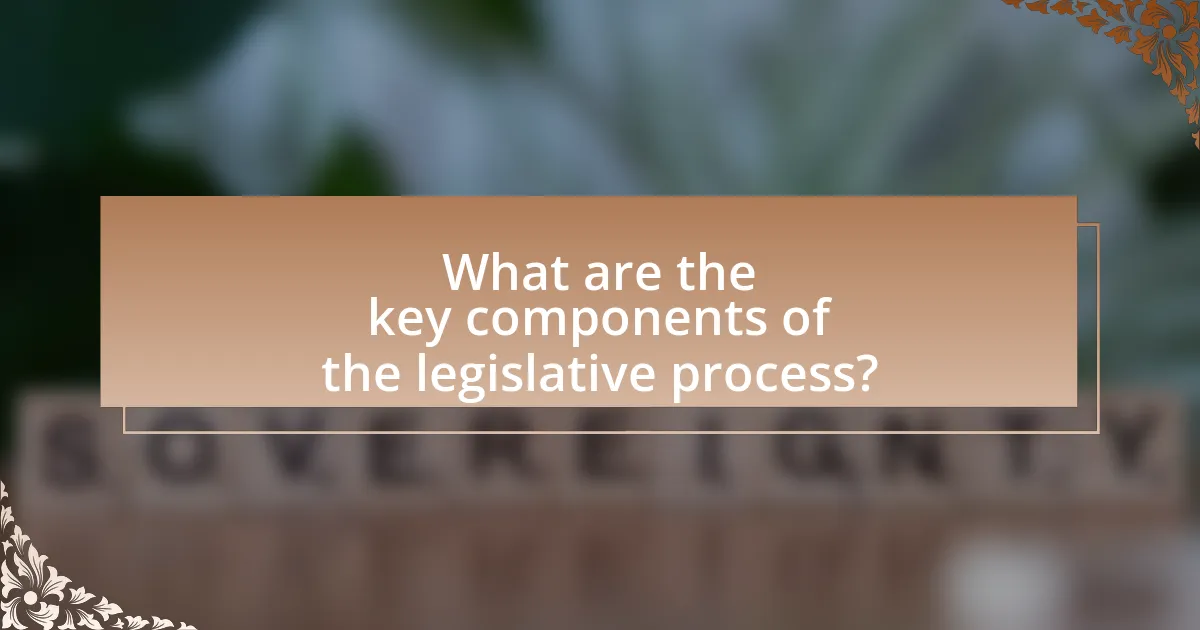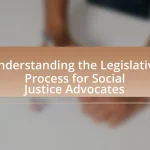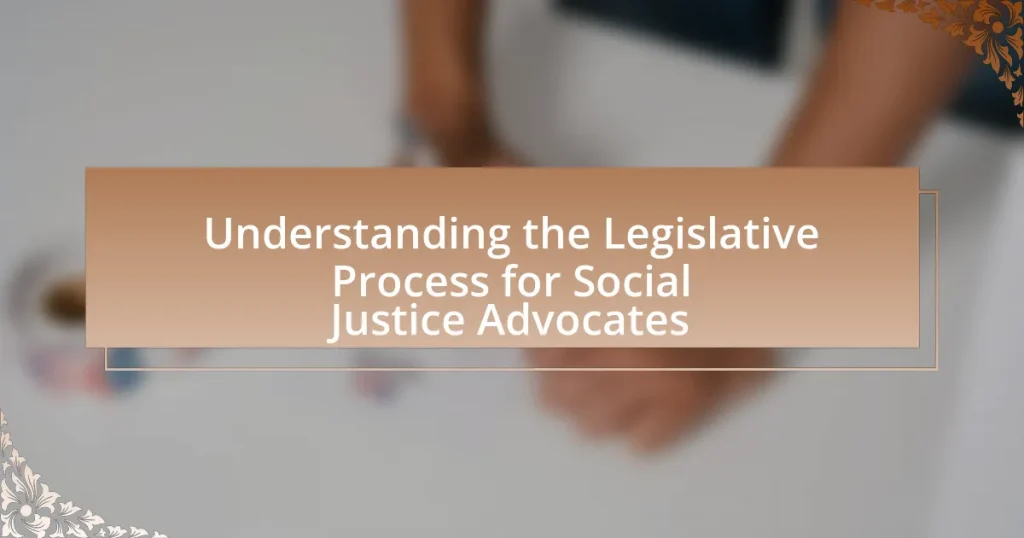The article focuses on the legislative process as it pertains to social justice advocates, detailing the essential steps involved, including issue identification, mobilization of support, drafting legislation, lobbying, and monitoring implementation. It emphasizes the significance of understanding this process for effectively influencing policy changes that address systemic inequalities. Key stages of the legislative process, the roles of different government branches, and strategies for advocacy are outlined, highlighting the importance of coalition building, effective communication, and engagement with lawmakers. Additionally, the article addresses the challenges advocates face and offers practical tips for enhancing their efforts within the legislative framework.

What is the Legislative Process for Social Justice Advocates?
The legislative process for social justice advocates involves several key steps: identifying issues, mobilizing support, drafting legislation, lobbying lawmakers, and monitoring implementation. Social justice advocates first identify specific social issues that require legislative attention, such as racial equality or environmental justice. They then mobilize community support and build coalitions to strengthen their advocacy efforts.
Next, advocates draft proposed legislation, often collaborating with legal experts to ensure the language is effective and comprehensive. Lobbying efforts are crucial, as advocates engage with lawmakers to persuade them to sponsor or support the proposed legislation. This may include providing data, personal stories, and expert testimonies to highlight the importance of the issue.
Finally, after a bill is introduced, advocates continue to monitor its progress through committees and votes, ensuring that it aligns with their goals and addressing any amendments that may arise. This process is supported by historical examples, such as the Civil Rights Act of 1964, which was the result of extensive advocacy and lobbying efforts by social justice groups.
How does the legislative process impact social justice initiatives?
The legislative process significantly impacts social justice initiatives by determining the creation, modification, and implementation of laws that address social inequalities. Through this process, advocates can influence policy decisions that promote equity, such as civil rights legislation, healthcare access, and education reform. For instance, the passage of the Civil Rights Act of 1964 was a direct result of legislative efforts aimed at dismantling systemic racism, showcasing how legislative action can lead to substantial social change. Additionally, the legislative process allows for public input and advocacy, enabling marginalized communities to voice their needs and priorities, which can lead to more inclusive and effective policies.
What are the key stages of the legislative process?
The key stages of the legislative process include introduction, committee review, floor debate, voting, and presidential action. During the introduction stage, a bill is proposed in either the House of Representatives or the Senate. The committee review stage involves examination and possible amendment of the bill by a specialized committee. Following this, the floor debate stage allows for discussion among all members, where further amendments can be made. The voting stage determines whether the bill passes in its current form, requiring a majority vote in both chambers. Finally, presidential action involves the president signing the bill into law or vetoing it, with Congress having the ability to override a veto with a two-thirds majority in both chambers. These stages are essential for transforming a proposed idea into enacted legislation.
How do social justice advocates engage at each stage?
Social justice advocates engage at each stage of the legislative process by employing specific strategies tailored to influence policy outcomes. At the agenda-setting stage, they raise awareness about social issues through campaigns and grassroots mobilization, ensuring that their concerns are recognized by policymakers. During the formulation stage, advocates participate in drafting legislation, providing expert testimony, and collaborating with lawmakers to shape proposals that reflect their goals. In the adoption stage, they mobilize public support and lobby legislators to secure votes for the proposed laws. Finally, at the implementation stage, social justice advocates monitor the enforcement of laws and policies, ensuring compliance and advocating for necessary adjustments to address any shortcomings. This structured engagement is crucial for advancing social justice initiatives effectively within the legislative framework.
Why is understanding the legislative process crucial for social justice advocates?
Understanding the legislative process is crucial for social justice advocates because it enables them to effectively influence policy changes that address systemic inequalities. By comprehending how laws are made, advocates can identify key decision-makers, engage in strategic lobbying, and mobilize community support to push for legislation that promotes social equity. For instance, the passage of the Civil Rights Act of 1964 illustrates how organized advocacy and a clear understanding of legislative procedures can lead to significant social change, as activists successfully navigated Congress to secure protections against discrimination.
What challenges do advocates face in navigating the legislative process?
Advocates face significant challenges in navigating the legislative process, including limited access to lawmakers, complex legislative procedures, and competing interests. Limited access to lawmakers can hinder advocates’ ability to communicate their positions effectively, as many legislators have tight schedules and prioritize constituents over external advocates. Complex legislative procedures, such as understanding the intricacies of bill drafting, committee processes, and voting protocols, can overwhelm advocates who may lack formal training in legislative affairs. Additionally, competing interests from lobbyists and other advocacy groups can dilute the impact of advocates’ efforts, making it difficult to gain traction for their causes. These challenges are well-documented in studies highlighting the barriers faced by grassroots organizations in influencing policy outcomes.
How can knowledge of the process enhance advocacy efforts?
Knowledge of the legislative process enhances advocacy efforts by equipping advocates with the tools to navigate and influence policy effectively. Understanding the stages of legislation, from proposal to enactment, allows advocates to identify critical moments for intervention, such as committee hearings or public comment periods. For instance, research by the National Council of Nonprofits indicates that organizations familiar with legislative timelines can mobilize supporters at key junctures, increasing the likelihood of favorable outcomes. This strategic engagement is essential for amplifying voices and ensuring that advocacy efforts align with legislative priorities, ultimately leading to more impactful social justice initiatives.

What are the key components of the legislative process?
The key components of the legislative process include the introduction of a bill, committee review, floor debate, voting, and presidential approval. The introduction of a bill marks the beginning of the legislative process, where a proposed law is formally presented in either the House of Representatives or the Senate. Following this, the bill undergoes committee review, where it is examined, amended, and voted on by a smaller group of legislators. If the bill passes the committee stage, it moves to the floor debate, where all members discuss its merits and propose further amendments. After debate, the bill is put to a vote; if it receives majority support, it advances to the other chamber for a similar process. Finally, if both chambers approve the bill, it is sent to the president for approval or veto. This structured process ensures thorough examination and debate of proposed legislation, reflecting democratic principles in law-making.
What roles do different branches of government play in legislation?
The legislative process involves three branches of government: the legislative, executive, and judicial branches, each playing distinct roles. The legislative branch, primarily composed of Congress, is responsible for drafting, proposing, and voting on laws. The executive branch, led by the President, has the authority to sign legislation into law or veto it, influencing the final outcome of proposed laws. The judicial branch interprets laws and can rule on their constitutionality, thereby affecting how legislation is applied and enforced. This separation of powers ensures a system of checks and balances, as established by the U.S. Constitution, which is crucial for maintaining democratic governance and protecting individual rights.
How does the executive branch influence legislative outcomes?
The executive branch influences legislative outcomes primarily through the power of veto, which allows the President to reject bills passed by Congress. This power serves as a significant check on legislative decisions, compelling lawmakers to consider the executive’s priorities and preferences when drafting legislation. Additionally, the executive branch can shape legislative agendas by proposing policies and initiatives during the State of the Union address or through executive orders, thereby guiding Congress on issues deemed important. Furthermore, the executive branch often engages in lobbying efforts, mobilizing resources and public support to sway legislative action in favor of its objectives. Historical examples include President Lyndon B. Johnson’s Great Society initiatives, which were advanced through strategic collaboration with Congress, demonstrating the executive’s ability to drive legislative change.
What is the role of the judiciary in the legislative process?
The judiciary’s role in the legislative process is to interpret and apply laws passed by the legislature, ensuring they align with constitutional principles. This function includes reviewing the legality of legislative actions and determining if laws violate constitutional rights. For example, landmark cases such as Marbury v. Madison established the principle of judicial review, allowing courts to invalidate laws that conflict with the Constitution. This oversight helps maintain a balance of power among branches of government and protects individual rights, thereby influencing the legislative process by prompting lawmakers to consider constitutional implications when drafting legislation.
How do committees function within the legislative process?
Committees function as specialized groups within the legislative process that review, amend, and recommend legislation. They play a critical role by conducting hearings, gathering expert testimony, and scrutinizing bills before they reach the full legislative body for a vote. For instance, in the United States Congress, committees can be categorized into standing, select, and joint committees, each serving distinct purposes such as oversight, investigation, or specific policy areas. This structure allows for a more efficient examination of complex issues, ensuring that proposed laws are thoroughly vetted and informed by expert input. The effectiveness of committees is evidenced by their ability to manage the legislative workload, as they handle the majority of the detailed work involved in lawmaking, which is essential for informed decision-making in the legislative process.
What types of committees are involved in social justice legislation?
The types of committees involved in social justice legislation include standing committees, subcommittees, and special committees. Standing committees, such as those focused on judiciary or civil rights, review proposed legislation and conduct hearings. Subcommittees, which operate under standing committees, delve into specific issues like housing or education equity. Special committees may be formed to address urgent social justice issues, conducting investigations or making recommendations. These committees play a crucial role in shaping, amending, and advancing social justice legislation through the legislative process.
How can advocates effectively engage with committees?
Advocates can effectively engage with committees by preparing thoroughly, building relationships, and presenting clear, evidence-based arguments. Preparation involves understanding the committee’s agenda, priorities, and members’ interests, which allows advocates to tailor their messages accordingly. Building relationships with committee members fosters trust and opens lines of communication, making it easier for advocates to influence discussions. Presenting clear, evidence-based arguments, supported by relevant data or case studies, enhances credibility and persuades committee members to consider the advocate’s perspective. For instance, a study by the National Conference of State Legislatures highlights that advocates who provide specific data and personal stories are more likely to sway legislative opinions.

What strategies can social justice advocates use in the legislative process?
Social justice advocates can employ strategies such as grassroots mobilization, coalition building, and targeted lobbying to influence the legislative process. Grassroots mobilization involves organizing community members to raise awareness and demonstrate support for specific issues, which can lead to increased pressure on legislators. Coalition building allows advocates to unite various organizations and stakeholders, amplifying their collective voice and resources, as seen in movements like the Civil Rights Movement, which successfully leveraged diverse groups to push for legislative change. Targeted lobbying entails directly engaging with lawmakers to present research, personal stories, and data that highlight the importance of specific policies, exemplified by the advocacy efforts surrounding the Affordable Care Act, where stakeholders effectively communicated the need for healthcare reform. These strategies, when effectively implemented, can significantly enhance the impact of social justice advocacy within the legislative framework.
How can advocates build coalitions to strengthen their efforts?
Advocates can build coalitions to strengthen their efforts by identifying shared goals and aligning their missions with like-minded organizations. This collaborative approach enhances resource sharing, increases visibility, and amplifies collective impact. For instance, the National Council of Nonprofits highlights that coalitions can leverage diverse expertise and networks, which can lead to more effective advocacy strategies and greater influence in legislative processes. By fostering relationships through regular communication and joint initiatives, advocates can create a unified front that is more persuasive to policymakers and stakeholders.
What are the benefits of collaborating with other organizations?
Collaborating with other organizations enhances resource sharing, amplifies advocacy efforts, and fosters innovation. By pooling resources, organizations can access a broader range of expertise, funding, and networks, which increases their overall impact. For instance, a study by the Stanford Social Innovation Review found that collaborative efforts can lead to a 30% increase in project effectiveness due to shared knowledge and skills. Additionally, joint advocacy initiatives can create a unified voice that is more persuasive in legislative processes, thereby improving the chances of achieving social justice goals.
How can coalitions amplify the voices of marginalized communities?
Coalitions can amplify the voices of marginalized communities by uniting diverse groups to advocate for shared goals, thereby increasing their collective influence. This collaborative approach allows for pooling resources, sharing expertise, and enhancing visibility in legislative processes. For instance, coalitions like the National Domestic Workers Alliance have successfully lobbied for labor protections by representing the interests of domestic workers, a historically marginalized group. By leveraging the strength of numbers and fostering solidarity, coalitions can effectively challenge systemic inequalities and push for policy changes that benefit underrepresented populations.
What communication strategies are effective for social justice advocacy?
Effective communication strategies for social justice advocacy include storytelling, coalition building, and leveraging social media. Storytelling engages audiences emotionally, making complex issues relatable; for instance, personal narratives can humanize statistics about social injustices. Coalition building fosters collaboration among diverse groups, amplifying voices and resources, as seen in movements like Black Lives Matter, which unite various organizations for a common cause. Leveraging social media allows advocates to reach wider audiences quickly, facilitating real-time engagement and mobilization, evidenced by the rapid spread of information during events like the Women’s March. These strategies collectively enhance the impact of advocacy efforts by creating awareness, fostering solidarity, and driving action.
How can storytelling be used to influence legislators?
Storytelling can influence legislators by humanizing issues and making complex policies relatable. When advocates share personal narratives or case studies, they create emotional connections that can sway legislative opinions and decisions. Research indicates that stories can increase empathy and understanding, which are crucial in the legislative process. For instance, a study published in the journal “Political Psychology” found that narratives significantly impact political attitudes and behaviors, demonstrating that well-crafted stories can effectively alter perceptions and motivate action among lawmakers.
What role does social media play in advocacy campaigns?
Social media serves as a crucial tool in advocacy campaigns by facilitating communication, mobilizing supporters, and amplifying messages. It enables organizations and individuals to reach a broad audience quickly, allowing for real-time engagement and feedback. For instance, campaigns like the #MeToo movement utilized platforms such as Twitter and Facebook to raise awareness and foster community support, resulting in significant societal and legislative changes. According to a Pew Research Center study, 69% of adults in the U.S. use social media, highlighting its potential to influence public opinion and drive advocacy efforts effectively.
What are best practices for engaging with lawmakers?
Best practices for engaging with lawmakers include establishing clear communication, being concise, and providing relevant data to support your position. Clear communication ensures that lawmakers understand your message, while conciseness respects their time and increases the likelihood of your message being heard. Providing relevant data, such as statistics or case studies, strengthens your argument and demonstrates the importance of the issue at hand. For instance, research from the Pew Research Center indicates that lawmakers are more likely to respond positively to constituents who present well-supported arguments.
How can advocates prepare for meetings with legislators?
Advocates can prepare for meetings with legislators by conducting thorough research on the legislator’s background, current priorities, and relevant legislation. This preparation allows advocates to tailor their message effectively, ensuring it aligns with the legislator’s interests and the needs of their constituents. Additionally, preparing concise talking points and personal stories can help illustrate the impact of the issues at hand, making the conversation more relatable and compelling. Engaging in role-playing or mock meetings can further enhance confidence and clarity in communication.
What follow-up actions are essential after engaging with lawmakers?
Essential follow-up actions after engaging with lawmakers include sending a thank-you note, providing additional information or resources, and maintaining ongoing communication. Sending a thank-you note reinforces the relationship and shows appreciation for their time and consideration. Providing additional information or resources can help lawmakers make informed decisions and demonstrates commitment to the issue. Maintaining ongoing communication ensures that advocates remain on lawmakers’ radar and can influence future discussions or decisions. These actions are crucial for building rapport and fostering a collaborative environment for social justice initiatives.
What practical tips can enhance advocacy efforts in the legislative process?
To enhance advocacy efforts in the legislative process, advocates should build strong relationships with legislators and their staff. Establishing trust and open lines of communication allows advocates to effectively convey their messages and influence policy decisions. Research indicates that personal connections significantly increase the likelihood of legislative support; for instance, a study by the National Conference of State Legislatures found that legislators are more likely to respond positively to constituents they know personally. Additionally, advocates should provide clear, concise information and data to support their positions, as evidence-based arguments are more persuasive. Engaging in grassroots mobilization can also amplify advocacy efforts, as demonstrated by the success of campaigns that mobilized large numbers of constituents to contact their representatives, leading to increased legislative action.










